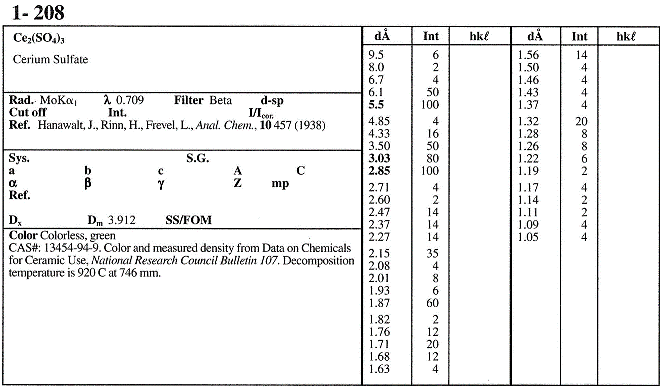 |
Databases for Qualitative PXRD |
 |
Databases for Qualitative PXRD |
Databases for Qualitative PXRD
Introduction
In general databases for PXRD qualitative analysis fall into one of two categories:
There are advantages and disadvantages to both types of database. Both types may be combined into a single database for the purpose of "Search-Match" as used in qualitative PXRD.
Early Databases
Initially, early “databases” were local access only and created by individuals from materials that they worked on. Small databases of PXRD data were published in 1927 and 1936 by A. N. Winchell and A. W. Waldo, respectively. However, a significant milestone was the publication of a database of about 1000 experimental PXRD patterns in 1938 by Hanawalt, Rinn and Frevel, of the Dow Chemical Company, which was published and distributed under the auspices of the American Society for Testing and Materials (ASTM) in the USA and the Institut of Physics in the UK (IoP). [Reference: Industrial Engineering Chemistry Analytical Edition 1938, 10, 457-512 and reprinted as a historical article in Powder Diffraction 1986, 1, 2-14.] A historical copy is on view at the International Centre for Diffraction Data (ICDD) in Newtown Square, Pensylvannia, USA.
The original database consisted of a set of physical cards, one card for each material as shown below:

Further details about the contents of this card (©ICDD 1967) are available by clicking on the different areas of the image.
In 1962, the d, I / I1 values, plus the chemical formulae and PDF index number were recorded as a computer-readable database, which became became known as PDF-1 (PDF = Powder Diffraction File™).
In the 1970s, a full card index with much information about the PXRD experimental data, but still based around d and I / I1 values, became available; this is now known as the PDF-2 database, with the last printed cards being published by the ICDD in 1987. Since this date, distribution and sale of the database has been via magnetic tapes in the 1980s (e.g. TK50s), and then via CDroms and DVD discs to the current period as shown below:

Despite computerisation, display of the experimental PXRD data in PDF-2 format remains essentially unchanged with a "card image" for Ce2(SO4)3 from the very first PDF Set 1 shown below as it appeared in the format of 1996:

and as the card data shown earlier on magnesium silicate appears when opened by the ICDD database software in 2013:
 w
w
PDF-3 and PDF-4 Databases
A lot of PXRD information is thrown away with the reduction of experimental data to PDF-2 format, for example peak shape. With modern data storage facilities, the archiving of 1-dimensional PXRD data is trivial. With the PXRD laboratory at UCL, we have an archive of data going back over 2 decades, all of which is on-line and still computer readable. The PDF-3 database was introduced as an archive database of full powder diffraction patterns, from which PDF-2 style data can be obtained. Although not so useful for Search-Match as used in qualitative PXRD, PDF-3 is potentially more useful for quantitative analysis.
The PDF-2 format may not be so useful for Search-Match for data collected under conditions other than ambient on a laboratory instrument. In addition, the conversion to d-spacing values, while removing the wavelength dependence on 2θ values, makes no allowance for the different intensities observed with different wavelengths due to different geometric corrections. However, a database based on crystal structures permits the calculation of PXRD patterns for any wavelength, and this is the underlying concept behind the PDF-4 database. PDF-4 permits comparison of full profile patterns against experimental data in Search-Match as the PXRD pattern can be calculated from a combination of the structure and instrumental profile. A comparison of the features available in PDF-2 and PDF-4 is provided in the sales literature by the ICDD as shown below:

and in particular, the following PDF-4 capabilities are noted:

Supply of Databases
The Joint Committee for Chemical Analysis by Powder Diffraction Methods was founded in 1938 data and published the first data set that forms the current ICDD PDF database. With the growth of the database, the Joint Committee on Powder Diffraction Standards (JCPDS) was established in 1969 whose mission was to maintain the PDF database. Consequently, the database became known colloquially as the JCPDS database for many years (and is still referred to as such by some people!). In 1978, the organization changes its name to the International Centre for Diffraction Data to highlight the global commitment of this endeavour, and it is now housed in a modern purpose-built building in Newtown Square, Pennsylvania. In contrast to "free" databases (see below), data curated by the ICDD is assessed for quality and reliability.
The subject of paying for data created by the academic community in the first instance is not without controversy, particularly in the Internet Age, where many feel that everything should be "free". In the same way that crowd-funded investments have occasionally bypassed the banks, so the equivalent crowd-volunteered approach has led to developments such as Wikipedia. In the field of PXRD databases, the equivalent is the Crystallography Open Database, known by its initials COD:

COD has its uses, but as with many things in life, you get what you pay for: database checking and curation costs time and money. Equally useful are local databases based on ones own measurements of known materials.
|
|
|